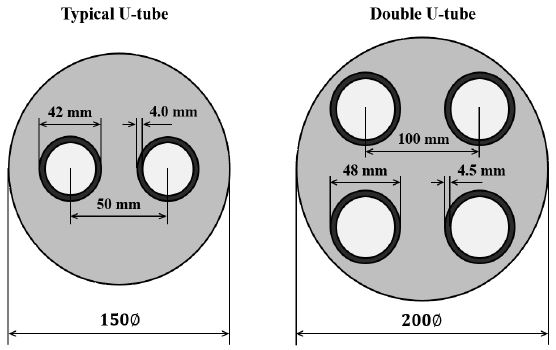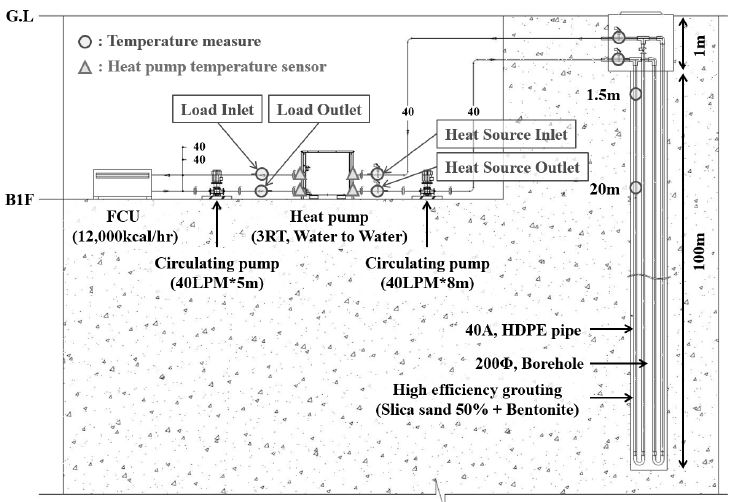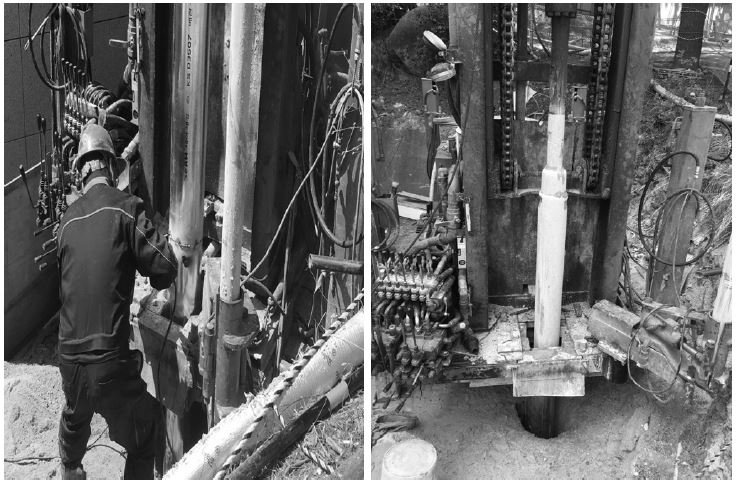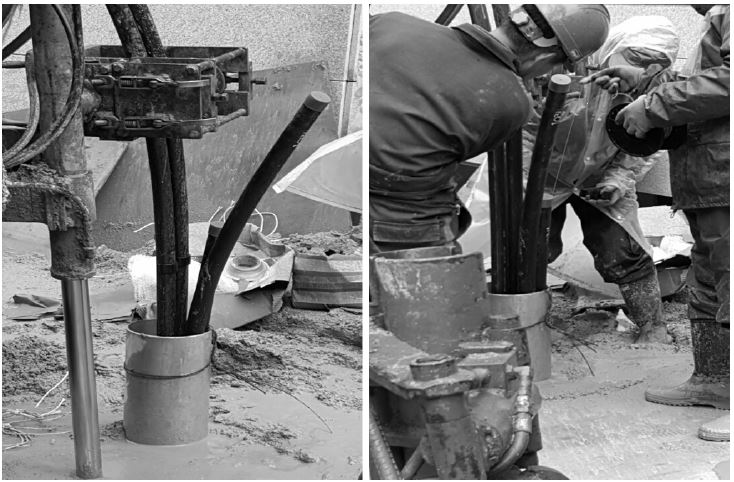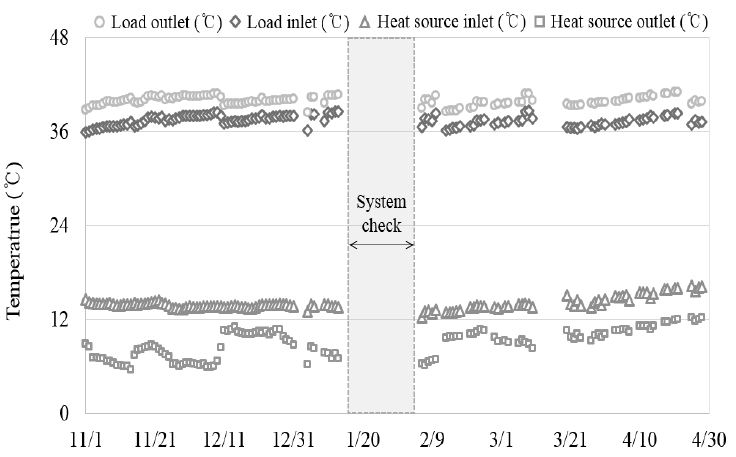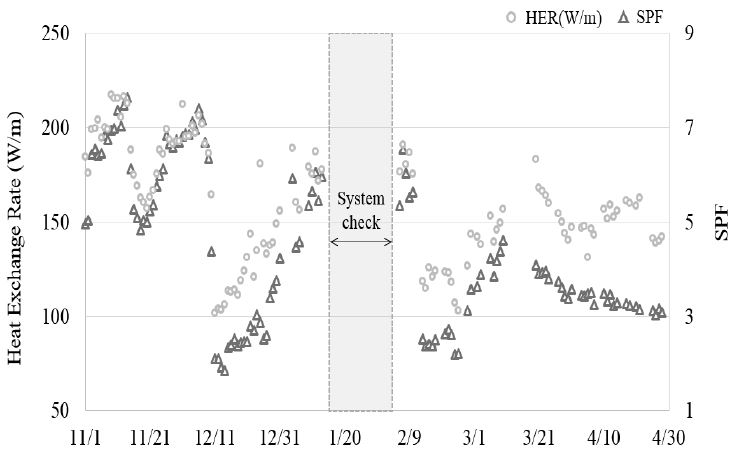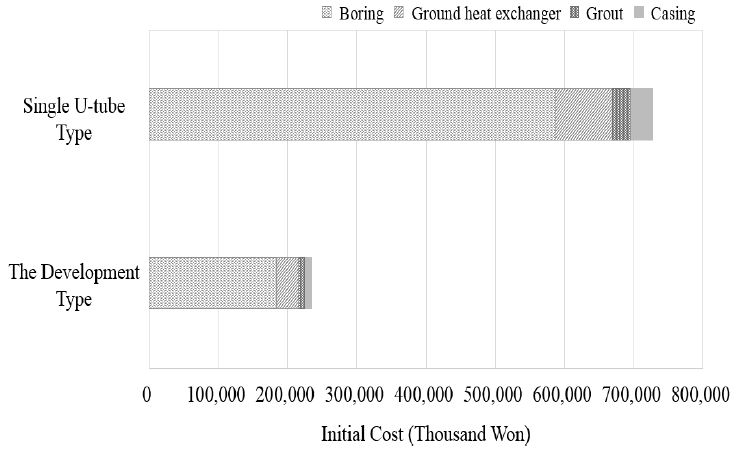
Feasibility Study of High-Efficiency Ground Heat Exchanger using Double U-tube through a Real-Scale Experiment
ⓒCopyright Korea Institute of Ecological Architecture and Environment
Abstract
The use of renewable energy system is essential for building energy independence and saving energy consumption in the building sector. Among renewable energy technologies, ground source heat pump(GSHP) system is more energy-efficient and environmental-friendly than other heat source systems due to utilize stable ground heat source. However, the GSHP system requires a high initial installation cost and installation space in limited urban area, so it is difficult to have superiority in the market of heat source system. Therefore, it is necessary to develop the installation method of low-cost and improve system performance. This paper aims to evaluate the performance of double u-tube ground heat exchanger(GHX) and verify system feasibility through real-scale experiment.
In this study, the real-scale experiment of vertical closed-type GSHP system was conducted using double u-tube GHX and high-efficiency grout. Through the verification experiment, heat source temperature, heat exchange rate(HER) and seasonal performance factor(SPF) were measured according to the long-term operation. In addition, the feasibility analysis was conducted comparing to the single u-tube system.
In the results of experiment, average HER was 136.27 W/m and average SPF was 5.41. Furthermore, compared to the single u-tube, the installation cost of the developed system could be reduced about 70% in the same heating load condition.
Keywords:
Ground source heat pump system, Ground heat exchanger, Real-scale experiment키워드:
지열 히트펌프 시스템, 지중열교환기, 실증 실험1. Introduction
The ground source heat pump (GSHP) system which utilizes stable underground heat source, is divided into vertical type and horizontal type according to the type of the ground heat exchanger. [1]. Generally, widely used vertical closed-type GSHP system responds to the cooling ,heating and hot water loads of buildings by using the geothermal energy existing 100m ~ 150m below the ground. Such GSHP system is becoming big issue as an essential renewable energy technology in the zero energy building (ZEB) for energy independence and energy consumption in the building sector. However, the GSHP system has difficulty in securing and supplying market competitiveness to other heat source systems due to uncertainty of system performance compared with high initial investment cost and limitation of installation area in urban areas. Therefore, it is necessary to develop a method of reducing installation cost and improving the performance of system within a limited system installation area to secure competitiveness and spread of vertical closed-type GSHP system.
To improve performance of system and reduce initial installation cost, development of ground heat exchanger innovative installation method, derivation of design factor and system performance evaluation are performed in various aspects using verification experiment or numerical simulation. Kong et al. [2] analyzed the thermal behavior of the soil according to the surface conditions of the ground heat exchanger using CFD simulations to evaluate the performance of the GSHP system according to the shape of the ground heat exchanger. Luo et al. [3] measured ground thermal conductivity through enhanced geothermal response test (EGRT) and measured groundwater flow rate using a flow meter test. Through the test results, the effect of ground heat exchanger on the performance was quantitative analyzed and it was confirmed the groundwater flow could improve the heat transfer efficiency of the ground heat exchanger. Shang et al. [4] conducted experiments on the temperature change of the soil through the operation of the GSHP system, constructed an experimental database conducting heating from November to March intermittently. through the analysis results and experimental database, the design factor affected the system performance and predicted for changes in ground temperature. Zarrella et al. [5] constructed the simulation model of GSHP system and conducted a case study on various types of ground heat exchangers.
In domestic studies, Jung et al. [6] analyzed the COP and pump consumption power of GSHP system according to flow control using simulation, and proposed the necessity of flow control method. As a result, the system COP increased sharply as the flow rate increased, but the same pattern of COP was observed at the level above the certain level. Ahn and Kim [7] examined the power consumption and the performance index of the heat pump according to the entering water temperature (EWT) change through a real-scale experiment. The experimental results showed that as EWT value of the ground heat exchanger was lower, the performance index was higher and the energy saving effect increased, operating the system efficiently. Hong and Choi [8] estimated the system cooling performance for a water-to-water vertical closed-type GSHP system. As a result of operating the system using the heat pump with the cooling capacity of 18 kW, the system was not able to reach the set temperature of 22℃ and maintained a temperature of 27.7℃ or higher, showing the limitation in the cooling of the zone of 26m×26m. Sohn et al. [9] used the building foundation (Pile) as the way to reduce the installation cost of a GSHP system and analyzed the heat transfer performance and system operation performance of the energy file through dynamic characteristics simulation. Lim et al. [10] conducted experiments on two sites in Korea using a thermal response test (TRT) device to measure the performance of the vertical closed-type GSHP system. As a result of TRT experiment for two experimental sites, the ground property was similar but the thermal conductivity showed the difference of 48.8%. This was judged to be caused by groundwater flow and climate change. Cha et al. [11] designed to enable heating operation by dividing the heat exchange between refrigerant and heat source water into the parallel flow and the counter flow using 3-way valve to improve the performance of GSHP system. The system performance according to the ground heat exchange system was compared and analyzed.
The development of design method to reduce the initial installation cost of system and the researches on the derivation of the design factors for improving the performance of the ground heat exchanger are under way by using the verification experiment or the numerical simulation. However, researches conducted in Korea are mainly experimental studies and the researches on vertical closed-type GSHP system using commonly-available single U-tube of 100m ~ 150m deep underground are mainly conducted.
In this experiment, to spread remarkably, secure market competitiveness, and improve system performance of vertical closed-type GSHP system, by using double U-tube ground heat exchanger and high-efficiency grout material, it is possible to secure superior ground heat exchange rate within a limited space and narrow space, and to reduce the number of boreholes required according to the building load such as heating, cooling and hot water. The performance of this double U-tube ground heat exchanger is expected to be equivalent or better than the single U-tube GSHP system can be. In addition, as the number of boreholes installed to cope with the required load of the building is reduced, the limited installation area and the initial investment cost can be reduced, which is a breakthrough alternative in the domestic market where system are difficult.
In this study, the long-term operation of a vertical closed-type GSHP system using double U-tube ground heat exchanger was performed to measure the load and the heat source temperature. The ground heat exchange rate of system and the seasonal performance factor (SPF) was analyzed according to the heating operation through the results of temperature measurement. Furthermore, feasibility analysis was conducted the GSHP system using double U-tube ground heat exchanger, and compared the performance and economic efficiency with the existing single U-tube GSHP system.
2. Experiment Outline and Experiment Method
2.1. Experiment Outline
In this study, to overcome the disadvantages of the existing GSHP system, and to reduce the initial installation cost and improve the performance of system remarkably, developed the double-tube ground heat exchanger model and compare to the conventional GSHP system in the same heating condition through conducted a real-scale experiment.
Fig. 1 shows borehole applying single U-tube generally used and borehole applying double U-tube developed in this study. In Korea, studies such as verification experiment and numerical simulation have been conducted mainly using single U-tube ground heat exchanger with a borehole diameter of 150Φ and a pipe diameter of 32A. [12,13] In this study, a real-scale experiment was conducted by installing the large-diameter double U-tube ground heat exchanger with borehole diameter of 200Φ and pipe diameter of 40A.
Fig. 2 shows a schematic diagram of the GSHP system used in this experiment. The GSHP system is vertical closed-type, consists of 3RT sized heat pump, 40LPM circulation pump, fan coil unit (FCU) and 100m deep borehole is installed. Double U-tube ground heat exchanger SDR 11, diameter of 40 was inserted at the center of borehole diameter 200Φ. In addition, to improve the heat exchange and heat transfer efficiency between the ground heat exchanger and the soil, a high efficiency grout material mixed with 1: 1 silica sand and bentonite was used.
To accurately measure the temperature change of circulating water due to the circulation of the heat source in the ground heat exchanger, thermo couple was installed at depths of 1.5m and 20m of ground heat exchanger, and a circulation water temperature was measured by attaching a temperature sensor to inlet and outlet of heat source and load on the heat pump.
For the underground machine room in the M building of P university in Busan, the ground heat exchange rate test was conducted by installing a GSHP system during the heating operation. (Fig. 3, 4).
<Table 1> shows detailed specifications of the experimental equipment used in this experiment. Heat pump is a water-to-water type, which is somewhat less efficient than a water-to-air heat pump, but has the advantage of easy maintenance. furthermore, it reduced leakage and mechanical loss of refrigerant (R22) by using scroll type compressor. The circulation flow rate of geothermal heat and hot and cold water in the heat pump was set at 80 L/min, and used the device that heating capacity was 10.69 kW and power consumption during heating was 3.35 kW. The fan coil unit used multi blade type used as circulation fan for general building ventilation and air-conditioning and heating system, and used the device that the flow rate in the fan coil unit was 29.3 L/min, the heating capacity was 14.30 kW, the power consumption during heating was 110W.
2.2. Experiment Method
In this experiment, during the system heating operation, the power consumption, and inlet/outlet temperature data of the heat source and load were measured at intervals of 1 minute, and heat pump was automatically set to perform on / off control by the inlet / outlet temperature of the load.
<Table 2> shows the system heating operating conditions. The outlet temperature of load was set to 40°C (deviation ± 2.5°C) The outlet temperature of heat source was set to 5 ℃ (deviation ± 1.0 ℃), and cold / hot water circulation flow rate was 80L/min heat, making heat source water from load and heat sources circulate at 40L/min each. Building type was assumed to be office building and 9 hours system heating operation was performed from 9:00 to 18:00 on weekdays excluding holidays and weekends during the operation period from November 1 to April 30.
To measure the accurate ground heat exchange rate and heat pump SPF of GSHP system using double U-tube ground heat exchanger, we calculated the ground heat exchange rate and heat pump SPF using the load and heat source temperature, and power consumption when the entire system (fan coil unit, heat pump and circulation pump) is operated within the operation time. In addition, we tried to find the system load ratio to confirm the operation time corresponding to the load during the system operation time.
The ground heat exchange rate per m unit of system heating operation was calculated from equation (1) using the flow rate of the circulating water, the specific heat, and the temperature difference between the inlet and outlet of heat source.
| (1) |
Here, Q is the ground heat exchange rate (W / m) per unit m, m is the circulating water flow rate (L / min), c is the specific heat of circulation (kJ / kg · K), ti is the inlet temperature of heat source, to is the outlet temperature of heat source (℃), and l is the length of the ground heat exchanger. The seasonal performance factor of the heat pump was calculated using equation (2) using the ground heat exchange rate calculated using equation (1) and the power consumption during heat pump operation.
| (2) |
Here, SPF is the seasonal performance factor of heat pump, Q is the heat capacity rate (W), and P is the heat pump power consumption (W). Since the overall facility equipment of the system including the heat pump, fan coil unit does not operate at the design rated capacity, the system is calculated using equation (3) for part-load ratio (PLR) to identify the actual operating state corresponding to the heating load.
| (3) |
Here, PLR is the system partial load ratio (%), Q is the secondary load (W), and the heating capacity (W) of the fan coil unit. This equation can be expressed as the ratio of the actual heating load (Q ) to the heating capacity (C ) in the full-load or steady-state system operation under the same rated load. [14]
3. Experiment result
3.1. Inlet and outlet temperature of load and heat source
We checked the entire system for the system check period, from January 13th to February 5th, 2017 (23 days), such as charging the refrigerant of heat pump, checking the geothermal heat circulation water and the pipe pressure gauge, checking the condensate of the fan coil unit and the control system, and the resulting data was missing.
Fig. 5 shows the inlet / outlet temperature of load / heat source. The mean inlet temperature on the load was 37.38 ℃, outlet temperature was 39.94 ℃, and the inlet and outlet temperature difference on the load was 2.55 ℃. The outlet temperature of load was maintained constant during the heating operation period, so it can be confirmed that the system operates stably. furthermore, the average inlet temperature on the heat source was 13.96 ° C, the average outlet temperature was 8.84 ° C, and the temperature difference was 5.12℃. Generally, the outlet temperature of heat source is lowered due to the reduction of the ground temperature during the long term operation of the system, but the inlet / outlet temperature of heat source measured in this experiment remained relatively stable because the load ratio was not large.
3.2. Ground Heat Exchange Rate and Heat Pump Seasonal Performance Factor
As the load that is actually required is not large, system operates under partial load operation, generally, ground heat exchange rate and heat pump SPF according to the long-term operation of the system shows a decreasing change, but real-scale experiment showed a change pattern that repeatedly increases and decreases.
Fig. 6 shows the ground heat exchange rate and the heat pump SPF. The average ground heat exchange rate was 136.27W/m during the operation period and the SPF of the heat pump heat pump was 5.41.
In previous studies [15] on the other hand, the ground heat exchange rate of borehole diameter 200Φ, depth 100m, diameter 32 single U-tube ground heat exchanger generally used was analyzed by numerical simulation. As a result of heating operation for 3 months (12/1 ~ 2/28) in winter, the ground heat exchange rate was 34.9W/m. As a result of comparing the ground heat exchange rate per borehole 1 hole of single U-tube and double U-tube, it is confirmed that the GSHP system using double U-tube has a 3.9 times better performance than the general GSHP system
3.3. Part-load Ratio
The system load ratio is the ratio of the actual heating load compared to the heating capacity of the fan coil uni, and we tried to check the part-load operation pattern for the heating set temperature 22 ℃.
Fig. 7 represents the load ratio in the system operation period. The average system load ratio was 47.41%. The system performance in November when the load ratio was high was better than other operation periods, and the ground heat exchange rate was 68% and the heat pump SPF was 45%.
On the other hand, in December and February when the part-load ratio was low, the system performance was below the average level during the operation period. This suggests that inverter control in geothermal systems is important and requires operation method to cope with partial loads. In the future, the system design and operation method corresponding to the load ratio will be developed.
4. Feasibility Analysis of System Introduction
4.1. Initial investment cost calculation
This study evaluated the validity of the introduction through comparative analysis of the existing single U-tube GSHP system and installation cost. In general, although the standard unit price [16] is announced in the "Standards for the Support of New and Renewable Energy Facilities" at the new renewable energy center, the construction cost of vertical closed-type GSHP system is different from the price of the actual construction company.
Therefore, in this study, the installation cost of single U-tube vertical closed-type GSHP system was referred to the system construction and installation work estimate of geothermal heat professional companies such as K and H, and double U-tube GSHP system analyzed the feasibility of introduction using the amount spent in this experiment.
<Table 4> shows the installation cost of the ground heat exchanger per hole of double U-tube and single U-tube. Single U-tube was borehole with a diameter of 150Φ, a ground heat exchanger with a diameter of 32 A and depth of 100 m. The installation cost per borehole 1 in double U-tube GSHP system used in this study was 23% higher than that of single U-tube.
4.2. Introduction feasibility analysis
Assuming that a building with a floor area of 400㎡ is 10 stories for business facilities to evaluate the feasibility of the introduction of double U-tube GSHP system, the investment cost for the introduction of the GSHP system was calculated. The unit heating load [17] of the business facility was calculated by referring to the “Standard of heating load unit of the general building” of the heating facility standard provided by Korea District Heating Corporation.
<Table 5> shows the unit heating load of the building type of business facility. A is the heating load when the radiator, fan coil unit is used, and B is that of the air harmonizer unit (AHU) used. In this study, the unit heating load of A (103.5W / ㎡) was used for the heating operation using fan coil unit. As a result, the heating load required at a floor area of 4000㎡ (floor area 400㎡, 10th floor) was calculated as 400kW. Therefore, the number of each borehole to correspond to required heating load when installing double U-tube and single U-tube was calculated. As a result, to correspond to the same load, borehole 30 holes were required for double U-tube (13.63 kW) and borehole 115 holes for single U-tube (3.49 kW).
Fig. 8 shows the cumulative installation cost for the number of boreholes of double U-tube and single U-tube. The installation cost of double U-tube was 235,800,000 won, and the installation cost of single U-tube was 727,720,000 won. The installation cost is about three times lower than that of single U-tube when using double U-tube under the same required load conditions. As the number of boreholes increased, manufacture and installation of the ground heat exchanger, grout, and casing did not affect the total installation cost, but the installation cost varied greatly depending on the excavation work.
5. Conclusion
In this study, the system performance and feasibility analysis were carried out by using double U-tube ground heat exchanger to improve ground heat exchange rate and reduce initial installation costs of the GSHP system. Through this, we tried to propose a breakthrough alternative considering the domestic situation which is difficult to diffuse and spread. The main conclusions of this paper can be summarized as follows.
(1) The temperature of the load and the heat source remained constant during the operation period, and the difference between the inlet and outlet temperature of load was 2.55°C and the difference between the inlet and outlet temperature of heat source was 5.12°C. Although the ground heat exchange rate is reduced due to the reduction of the temperature of ground heat source during long-term operation of the system, in this experiment, the system load ratio was not large enough to keep the heat source side temperature relatively stable.
(2) The average ground heat exchange rate during heating operation was 136.27W/m, and heat pump SPF was 5.41. As a result of comparing the GSHP system using single U-tube ground heat exchanger of commonly-available diameter 32A with the performance, ground heat exchange rate per 1 borehole improved 3.9 times.
(3) To cope with the heating load condition (400 kW) required in a 4,000 m²-sized business facility, double U-tube required 30 holes for borehole and single U-tube required 115 holes for borehole. The installation cost was reduced by three times that of single U-tube when using double U-tube, and the effect on the excavation work was the greatest during the installation process.
In the future, to commercialize double U-tube GSHP system, it is planned to measure the ground heat exchanger performance under various input conditions and conduct other heat source systems and economic analysis.
Acknowledgments
This work was supported by the Korea Institute of Energy Technology Evaluation and Planning (KETEP) and the Ministry of Trade, Industry & Energy (MOTIE) of the Republic of Korea (No. 20163030111350)
Reference
-
Sohn, Byong-Hu, Performance Analysis of Ground-Coupled Heat Pump System with Slinky-Type Horizontal Ground Heat Exchanger, Korean Journal of Air-Conditioning and Refrigeration Engineering, 24(3), (2012).
[https://doi.org/10.6110/kjacr.2012.24.3.230]

-
XIang-Ri Kong, Yelin Deng, Linyan Li, and Wei-Shem Gong, Experimental and numerical study on the thermal performance of ground source heat pump with a set of designed buried pipes, 114, p110-117, Applied Thermal Engineering, (2017).
[https://doi.org/10.1016/j.applthermaleng.2016.11.176]

- Jin Luo, Joachim Rohn, Wei Xiang, Manfred Bayer, Anna Priess, Lucas Wilkmann, Hagen Steger, and Roman Zorn, Experimental investigation of a borehole field enhanced geothermal response test and numerical analysis of performance of the borehole heat exchangers, 84, p473-484, Energy, (2015).
-
Yan Shang, Min Dong, and Sufen Li, Intermittent Experimental Study of a Vertical Ground Source Heat Pump System, 136, p628-635, Energy, (2014).
[https://doi.org/10.1016/j.apenergy.2014.09.072]

-
Angelo Zarrella, Giuseppe Emmi, and Michele De Carli, A Simulation-based Analysis of Variable Flow Pumping in Ground Source Heat Pump Systems with Different Types of Borehole Heat Exchangers : A Case Study, 131, p135-150, Energy Conversion and Management, (2017).
[https://doi.org/10.1016/j.enconman.2016.10.061]

-
Jung, Young-Ju, Jo, Jae-Hun, Kim, Yong-Sik, and Cho, Young-hum, A Study on the Geothermal Heat Pump System Performance Analysis according to Water Flow Rate Control of the Geothermal Water Circulation Pump, Journal of the Korean Solar Energy Society, 34(6), p103-109, (2014).
[https://doi.org/10.7836/kses.2014.34.6.103]

- Ahn, Byung-Chun, Kim, Jae-Wan, and , Yong-Sik, Cho, Young-hum, An Experimental Study on the Cooling Operation Characteristics for Different Entering Water Temperatures in Geothermal Heat Pump System, Transactions of the Korean Society of Geothermal Energy Engineers, 6(1), p1-7, (2010).
-
Hong, Boo-Pyo, and Choi, Kwang-Hwan, Experimental Study on the Cooling Performance of Vertical Closed Loop Water to Water Ground Source Heat Pump System, Journal of the Korean Solar Energy Society, 34(1), p58-63, (2014).
[https://doi.org/10.7836/kses.2014.34.1.058]

-
Sohn, Byong-Hu, Jung, Kyung-Sik, and Choi, Hang-Seok, Performance Prediction of Geothermal Heat Pump(GHP) System using Cast-in-Place Energy Piles, Korean Journal of Air-Conditioning and Refrigeration Engineering, 25(1), p28-36, (2012).
[https://doi.org/10.6110/kjacr.2013.25.1.028]

-
Lim, Kyoung-Bin, Lee, Chang-Hee, and Soung, Nak-Won, An Experimental Study on the Thermal Performance Measurement of Vertical Borehole Heat Exchanger(BHE), Transaction of the Korean Society of Mechanical Engineers – B, 30(8), p764-771, (2006).
[https://doi.org/10.3795/ksme-b.2006.30.8.764]

- Cha, Dong An, Kwon, Oh Kyung, and Park, Cha Sik, A Study on Heating Characteristics of Ground Source Heat Pump with Variation of Heat Exchange Methods, Transactions of the Korea society Geothermal Energy Engineers, 8(2), p9-15, (2012).
- Shintaro Ikeda, Wonjun Choi, and Ryozo Ooka, Optimization Method for Multiple Heat Source Heat Pump considering Dynamic variation in Ground Temperature, 193, p466-478, Applied Energy, (2017).
- Min, Kyong Chon, and Choi, Jae Ho, Effect of the Design Parameters of Geothermal Heat Exchanger Design Length, Transactions of the Korea society of Geothermal Energy Engineers, 2(2), p10-15, (2011).
- Reddy, T. Agami, Kreider, Jan F., Curtiss, Peter S., and Rabl, Ari, Heating and Cooling of Buildings Design for Efficiency, CRC press Taylor & Francis Group, (2014).
-
Nam, Yujin, Oh, Jin Hwan, Study on the Characteristic of Heat Exchanger for Vertical Geothermal System using the Numerical Simulation, Journal of the Korean Solar Energy Society, 34(2), p66-72, (2014).
[https://doi.org/10.7836/kses.2014.34.2.066]

- Base Price of new & Renewable Energy Source, Korea Energy Agency Korea New & Renewable Energy Center, (2012).
- Standard of Heating Load Unit, Design Criteria of Heat Energy Usage, Korea District Heating Corporation, (2012).
